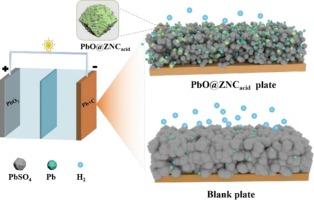Metal-organic framework-derived N, Zn-doped carbon materials loaded with PbO for suppressing hydrogen evolution and irreversible sulfation in lead-carbon batteries
IF 8.9
2区 工程技术
Q1 ENERGY & FUELS
引用次数: 0
Abstract
As an emerging electrochemical energy storage battery, lead-carbon batteries (LCBs) are characterized by with high safety, low cost, and long cycle life. However, due to the LCBs under high-rate partial state of charge (HPRSoC) conditions for a long time will lead to the phenomena of hydrogen evolution reaction (HER) and irreversible sulfation at the negative electrode, which seriously affects the performance of the batteries. In this work, MOFs-derived N, Zn-doped carbon (ZNCacid) modified with PbO (PbO@ZNCacid) was synthesized and applied as a negative electrode additive in LCBs. The ZNCacid substrate has microporous and mesoporous structure, which facilitates the diffusion of electrolyte. Among them, the doping of Zn can effectively suppress hydrogen evolution, while N doping will generate more defects and enhance the electronic conductivity. More importantly, the PbO particles loaded on the ZNCacid substrate not only inhibit HER but also provide nucleation sites for PbSO₄ crystal growth while enhancing the affinity between the carbon material and the negative active material (NAM). Owing to the superior properties of the synthesized PbO@ZNCacid material, the LCB incorporating this additive achieves a specific capacitance of 153.6 mAh·g−1 — a 38.74 % increase compared to the Blank battery (110.7 mAh·g−1).Under HRPSoC conditions, the cycle life of the modified-battery is 33,729 times, which is 5.68 times that of the Blank battery (5937 times). This work provides valuable references for the application of lead-carbon composites in LCBs.

负载PbO的金属有机骨架衍生N, zn掺杂碳材料抑制铅碳电池的析氢和不可逆硫化
铅碳电池作为一种新兴的电化学储能电池,具有安全性高、成本低、循环寿命长等特点。然而,由于lcb长时间处于高倍率部分充电状态(HPRSoC)条件下会导致析氢反应(HER)和负极不可逆硫酸化现象,严重影响电池性能。在这项工作中,合成了由mofs衍生的PbO (PbO@ZNCacid)修饰的N, zn掺杂碳(ZNCacid),并将其作为lcb的负极添加剂。锌酸基板具有微孔和介孔结构,有利于电解液的扩散。其中,掺杂Zn能有效抑制析氢,而掺杂N会产生更多缺陷,提高电子导电性。更重要的是,负载在ZNCacid底物上的PbO颗粒不仅抑制了HER,而且为PbSO₄晶体的生长提供了成核位点,同时增强了碳材料与负活性物质(NAM)之间的亲和力。由于合成PbO@ZNCacid材料的优异性能,加入该添加剂的LCB实现了153.6 mAh·g−1的比电容,比空白电池(110.7 mAh·g−1)提高了38.74%。在HRPSoC条件下,改性电池的循环寿命为33729次,是空白电池5937次的5.68倍。该工作为铅碳复合材料在lcb中的应用提供了有价值的参考。
本文章由计算机程序翻译,如有差异,请以英文原文为准。
求助全文
约1分钟内获得全文
求助全文
来源期刊

Journal of energy storage
Energy-Renewable Energy, Sustainability and the Environment
CiteScore
11.80
自引率
24.50%
发文量
2262
审稿时长
69 days
期刊介绍:
Journal of energy storage focusses on all aspects of energy storage, in particular systems integration, electric grid integration, modelling and analysis, novel energy storage technologies, sizing and management strategies, business models for operation of storage systems and energy storage developments worldwide.
 求助内容:
求助内容: 应助结果提醒方式:
应助结果提醒方式:


